| Feline Homeland of Barmenia Nkaé Jrt Brme | |||||
|---|---|---|---|---|---|
| |||||
 none Flag Coat of Arms none Flag Coat of Arms
| |||||
| Anthem | |||||
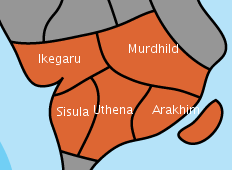
| |||||
| Capital Varishehr | |||||
| Languages Brmek, Kathuran, Selucian | |||||
| Demonym Barmenian | |||||
| Government Felinist theocracy Felis Supremis First Last Galt Freyja IV Chief Servant of the Cats First Last | |||||
| Legislature Grand Cat Parlour | |||||
| Area 856,800 km² | |||||
| Population | |||||
| Currency Barmenistan (BAR) | |||||
The Feline Homeland of Barmenia (Brmek: نکی یرت برمه Nkaé Jrt Brme) was the official name of Barmenistan when it was under the rule of the Felinist Cult of the Sacred Feline. The Feline Homeland was unique in Terran history in that its head of state, the "Felis Supremis", was non-human, that role being constitutionally reserved for cats.
History[]
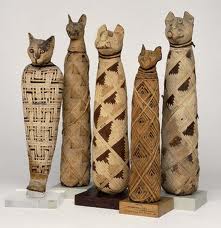
Bodies of cats mummified by our ancient Barmenian ancestors
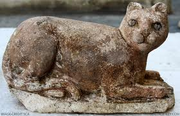
Ancient cat monument
The roots of Felinist belief are considered to be of ancient origin, but modern Felinism as a distinct organized religion did not emerge until the 32nd century. The government of the Feline Homeland considered much of Barmenian history before modern Felinism as a dark age of confusion, instability and backwardness. As such it made many attempts to discover ancient archeological evidence for the worship of cats while ignoring or even destroying much of the historical and archeological record of Barmenistan. Newly-found scrolls would tell of ancient cat worship. Bodies of mummified cats were frequently being dug up, as were monuments and objects associated with cat deities. Several sites were located where it was believed temples devoted to cats once stood. The National Cat Museum in Uthena was dedicated to studying and showcasing these artifacts with the end goal of demonstrating the longevity and authenticity of Barmenistan's national religion.
Cult of the Sacred Feline[]
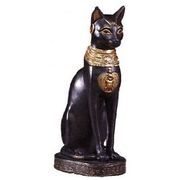
A monument dedicated to Bastet the Cat Goddess of Fertility

We need to enter deep within ourselves to approach the Feline Divinity
The government of the Feline Homeland was under the control of the Cult of the Sacred Feline, known as the Sacred Cult, which was founded by Lady Ershébef Kepahisn following a spiritual journey stretching across four decades of companionship with cats. After claiming revelation of the innate omniscience of cats, she set up the Sacred Cult in order to share the secrets of feline wisdom. The movement she inspired is known as Felinism, also called the Way of the Cat or the Feline Path. Its followers are called Felinists.
Orthodox Felinists, like Lady Ershébef and the priesthood of the Sacred Cult, literally believed that cats comprised the Godhead or Feline Divinity and that serving cats was the moral purpose humans are created for. Less orthodox Felinists, whilst according cats the highest place of honour, would take a more pantheistic view, seeing the worship of cats as a powerful metaphor for developing a closer relationship with the spirituality present within ourselves and in nature. Others took a syncretistic approach, venerating cats whilst also drawing on concepts from other religions. It used to be common for Felinists to also regard themselves as, say, Hosians, Ahmadis, Yeudis or Daenists and still feel comfortable with their beliefs and be fully accepted within the Felinist community. Felinists tended to feel especially close to other nature-based religions, such as paganism, Wicca and Heathenry.
The Sacred Cult was relaxed about the diversity within Felinism, requiring conformity to orthodox teaching only from its registered priesthood, which was jointly headed by Lady Ershébef Kepahisn as High Priestess and her son Jonafn Kepahisn as High Priest. It was the official established religion in Barmenistan and played a special role in running the office of the Head of State or Felis Supremis.
Lady Ershébef Kepahisn[]
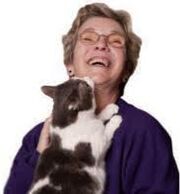
Bubbles with her companion Lady Ershébef Kepahisn
Felinists regarded their faith as a natural religion which has always existed in some form or degree, and so were reluctant to credit any single individual as being their founder. However, Lady Ershébef is inarguably the spark that began the modern Felinist movement. Although personally a very modest woman who shied from public attention, she acquired the status of a towering figurehead not only for the Sacred Cult and Felinism but for Barmenistan itself.
Lady Ershébef hailed from Barmenia's aristocracy and was born to great wealth, but her life was not an easy one. She became divorced after only six years of marriage because her husband resented the time and affection she lavished upon her growing menagerie of cats. The marriage produced two daughters and a son, but her youngest daughter, Maria, was sent to live with her father because of her worsening allergy to cats. Maria lost her father soon after, and had to live with an aunt instead, which was not a happy experience. Maria never forgave her mother for choosing cats over her, and her hostility towards feline worship and cats in general has ensured a continuing poor relationship between the two women. In contrast to this, Lady Ershébef's son Jonafn and daughter Jesík were very close to her, and both held positions of leadership in the Sacred Cult.
resided in her family castle in Uthena, where she played host to 284 cats. Many of her family members are interred there, and the building is now a national historical monument.
Discerning the General Feline Will[]

Educational visual aid for Barmenian nursery children
"Discerning the General Feline Will" was a phrase visitors to Barmenistan would mention hearing a lot in all sorts of situations, and they were often confused about what it meant. The term was of religious significance to Felinists, describing the process or state of mind which enabled one to humbly wait upon the Feline Divinity for guidance. Felinists would often rely on a Guide, meaning a cat who has come forward to help that person make their life choices.
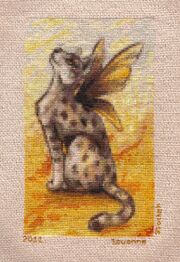
A cat was claimed to have telepathically communicated his wishes to an artist during a retreat at the Regional Uthena Cat Temple.
Most Felinists would spend time in consecrated Cat Temples expertly designed to encourage personal encounters with the Feline Divinity. The physical presence of cats and a cat-honouring environment was believed to be conducive to accessing the profundity of cat sprituality, but was considered neither essential nor a guarantee of success, since what is sought is believed to originate from a higher plane than the material world we perceive around us with our limited human senses. Felinists believe that cats see far more than this, and that they are generous animals who may share their visions if they are approached in the right way.
According to the tenets of the faith, a frequent pitfall, especially for newcomers to Felinism, is to consciously or unconsciously demand instant answers. In Felinist theology it is believed that seekers commonly become so intoxicated by their first fleeting brush with the Feline Divinity that their nervous systems become over-excited, they assume grandiose pretensions and then enter psychological breakdown as the feline pantheon collectively flick their tails in disgust and desert then. Felinists claim that Bastet only purrs for those who are worthy of the quest. Adventurers who are permitted into her presence but then incur her disgust can expect short shrift, as it is takes patience, devotion and humility to mature in the Feline Path. This is the claimed reason for the organisation of the Sacred Cult.
Cat Temples[]
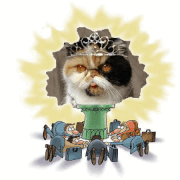
An artist's impression of a vision instructing him to finance the construction of a new Cat Temple
Every Barmenian city, town or village housed a network of Cat Temples, almost all of them affiliated to the Sacred Cult. Cat Temples were run for and by their cat residents, whose wishes were believed to be communicated to their appointed priests and priestesses who administered their decisions into practice. The average Temple featured every facility for cats; plenty of space for them to roam inside and outside; and opportunities for worship and discernment, including shrines and religious seminars. Many Temples sited farms and specialist kitchens on campus in order to provide the highest quality of fresh produce and cooked meals for their residents.
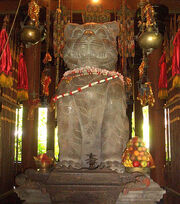
The famous Altar of Bastet at the East Sisula Cat Temple
The Temple Priesthood were assisted by a secular class of Servers, who could work in a Temple on a permanent or temporary basis. Most Barmenians would spend at least several months of their lives as Servers. The experience was considered both personally and spiritually invigorating, and was a social rite of passage for young adults. Many Barmenians would spend a large chunk of their active post-retirement years as Servers.
Government and politics[]
The concept of a Feline Homeland[]
Barmenistan was the first and only nation in Terra to declare herself a Feline Homeland, which is to say the full energies of her state and society were committed towards service to cats. Barmenistan had the highest possible legally-enforced standards of cat welfare in history, and every cat - living or dead - was accorded full citizenship status. This meant that the mistreatment of cats by by anyone, anywhere, anytime was an offence against a Barmenian citizen and could be prosecuted in the Court of Cat Law (CCL), which severely punished crimes committed against cats.
Felis Supremis[]
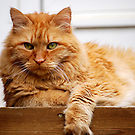
Felis Supremis listening to the Cabinet's proposals
The Felis Supremis, or Supreme Cat, played a dual religious and secular role in Barmenistan, serving both as a focal point for cat veneration and as the nation's ceremonial Head of State, in which capacity she was also Head of the Judiciary and Commander-in-Chief of the armed forces. Orthodox Felinists acknowledged the Felis Supremis as the living incarnation of Bastet, the Cat Goddess of Fertility worshipped in ancient times by Qedarite and Jelbic tribes. Whenever a Felis Supremis died, the nation subsided into ten days of official mourning, during which followers ceased all significant business activity, fasted, prayed, donated their riches to Cat Temples and wailed loudly through the streets whilst crawling on all fours with their eyes facing downwards, fearing that unless Bastet returned the plants would all die and all living life perish. On the eleventh day a search began, supervised by the Sacred Cult, to find the next Felis Supremis from amongst the kittens in Barmenistan's most prominent Cat Temples. The selected kitten was usually a queen (female), although there have been occasions when Bastet was claimed to have chosen to return as a tom (male). After the new Felis Supremis was been anointed, there followed an outburst of religious fervour and wild celebrations.
As Head of State, the Felis Supremis received dignitaries; presided over state ceremonies such as the opening of the Grand Cat Parlour (GCP) and the swearing in of the Cabinet; and held weekly audiences with the Head of Government, known as Chief Servant of the Cats. The administrative functions of the Felis Supremis were shouldered by a small bureaucracy run by the Sacred Cult and funded by the central government.
Felis Supremis resided in the luxurious setting of the GCP, where she was attended by a large team of servants working day and night to maintain her in the comfort necessary to ease the burden of her responsibilities.
Grand Cat Parlour[]
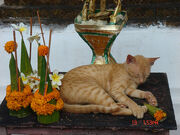
Receiving offerings at the Grand Cat Parlour

Frontage of the Grand Cat Parlour
The GCP was first and foremost a consecrated Cat Temple affiliated to the Sacred Cult. Alike other Cat Temples, it featured numerous feline residents; a Priesthood and team of Servers devoted to their welfare; a range of facilities dedicate to feline comfort and needs; opportunities for visitors to mingle amongst the Feline Divinity; and extensive surrounding grounds for the use of cats as well as various outdoor monuments and shrines for the facilitation of cat veneration. In addition to this, a minor part of the GCP's space and activity involved hosting Barmenistan's elected legislature, which sat regularly in a disused food preparation area.
Barmenian voters were expected to carefully meditate upon the guidance of the Feline Divinity before casting their votes, remembering that what mattered was the General Feline Will rather than insignificant selfish personal interests. Similarly, elected legislators were expected to reflect that the Feline Divinity put them where they were, and that their duty was to serve cats rather than becoming distracted by pointless squabbling. The chamber in which the legislature sat was open to the comings and goings of roaming cats, since within a Cat Temple it was sacrilegious to close a door on a cat. This was designed to afford legislators an enhanced opportunity to earnestly discern the General Feline Will. For example, it was not uncommon for debates in the chamber to be swung one way or the other by a cat showing favour or disfavour to a particular legislator at a critical moment.
Chief Servant of the Cats and Cabinet[]
Barmenistan's Head of Government was known as the Chief Servant of the Cats, his official title being designed to let him know what he was and what he was meant to be doing. He was assisted by twelve ministers, who with himself comprised the Cabinet, which he chaired. The Cabinet was appointed by the legislature and was constitutionally expected to command a majority of support within it, although periods of minority government were not impossible.
Judiciary[]
Barmenian law was mainly administered by district and regional courts. Above them, sat the Federal Court, which heard appeals against decisions made at lower tiers of the judiciary. Judges were appointed by the Justice Minister on the recommendation of an Independent Judicial Appointments Commissions. As with other senior public officials, judges had to swear an oath of allegiance to the Felis Supremis and pledge to uphold the Constitution.
Court of Cat Law[]
Barmenia also had a Court of Cat Law (CCL), the highest court in the land and, in Felinist belief, the highest court in Terra since the Law of Cats over-rides the Law of Man. CCL sessions were conducted on the authority of the Felis Supremis, whose decisions were communicated to priestly interpreters appointed the Sacred Cult. The CCL scrutinised legal developments on an ongoing basis to ensure Cat Law was being respected. In practice the CCL never overturned a judicial decision, although it did occasionally issue notes of guidance or requests for judges to clarify their rulings.
The CCL reserved for itself the right to try crimes involving the mistreatment of cats, and it had a reputation for issuing tough sentences.
Office for Covert Affairs[]

Lucy, Interrogations Supervisor at the Office for Covert Affairs
More controversial was the shadowy Office for Covert Affairs (OCA), a division of the CCL which also functioned as the national intelligence agency. Nicknamed "the Feline Inquisition", rumours exixted that the organization was involved with intimidating, kidnapping, torturing and murdering suspected perpetrators of cruelty to cats who escaped prosecution. Its operatives were also accused of conducting operations overseas to wreak retribution against those who harmed cats. Such unsavoury rumours were always officially denied, and an investigation by a parliamentary committee found that although certain interrogation methods were applied too enthusiastically, there was no evidence of torture or murder.
Politics and parties[]

Politicians were wrestling with concerns that some Cat Temples had so many cats that was is difficult to stalk prey without seeming too obvious
Barmenian culture frowned on bickering, and this attitude was reinforced by a national religion which suspected spiritual inattentivity in heated argument or insult-slinging. Housed within the precincts of a Cat Temple, Barmenistan's legislators were especially sensitive to this, knowing the opprobrium which would fall down upon them if they were seen to offend the sacredness of their surroundings. Politicians tended to be more loose-tongued outside legislative sittings and in the press, but foreigners were struck by the courtesy and friendly camaraderie which characterised Barmenian political life. Whilst differences always existed, there was a tradition of trying to achieve consensus across party lines rather than passing Bills on slender majorities.
Sacred Feline Alliance[]

Smudge with Jessica Rochford
The Sacred Feline Alliance (SFA) was set up in April 3133 by Jesík Kepahism, eldest daughter of Lady Ershébef Kepahisn. It promoted an unashamedly Felinist agenda, drawing from a range of thinking including socialism, liberalism and environmentalism, whilst ultimately aspiring to eschew the limitations of man-made ideology in favour of dependence upon the Feline Divinity in every aspect of formulating and applying solutions to human and ecological dilemmas.
Many SFA activists were very active in the Sacred Cult, but the two organisations were strictly independent of each other, and the Sacred Cult prohibited its Priesthood from standing for election to public office. Jesík was by far the most politically-minded of the Kepahisn family, the others being more concerned with religious affairs. Ershébef and Jonafn were known to be supportive of her endeavours, but were careful to appear aloof from politics. However the SFA was perceived by commentators as intimately entwined with the religious establishment.
